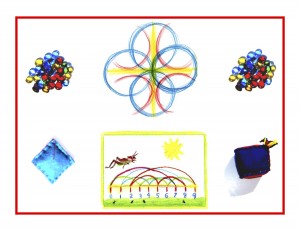Day 40
For one year, 365 days, this blog will address the Common Core Standards from the perspective of creating an alternate, ambient learning environment for math. Ambient is defined as “existing or present on all sides, an all-encompassing atmosphere.” And ambient music is defined as: “Quiet and relaxing with melodies that repeat many times.”
Why ambient? A math teaching style that’s whole and all encompassing, with themes that repeat many times through the years, is most likely to be effective and successful. Today’s post will focus on the Standard for Mathematical Practice #4. It’s paired with tomorrow’s (#5) standard as the third of four categories. These two are paired because they both focus on “modeling and using tools.”
As the creator of Math By Hand, and as a naturally can-do, hands-on person, I will find many aspects in common with today’s standard. It will appear in blue, followed by references to the blog posts aligned with it. All references that apply to older grades will be omitted.
Standards for Mathematical Practice
4. Model with mathematics.
Mathematically proficient students can apply the mathematics they know to solve problems arising in everyday life, society and the workplace. In early grades, this might be a simple as writing an addition equation to describe a situation.
A perfect example of this, storytelling to present and solve problems, can be found in the Day 10 and 12 posts, thanks to Peter Rabbit and Squirrel Nutkin. Aspects are taken from stories that have been told and are well known by the child(ren). Hands-on models are used to represent elements of the story, drawings made to illustrate the problem, and math then describes and or resolves the situation. This activity can evolve into solving word problems in the later grades. But a word of caution here. Please be sure that word problems are reality-based! Nothing is more alienating than being asked to solve a problem that has no point and / or any real meaning.
Mathematically proficient students who can apply what they know are comfortable making assumptions and approximations to simplify a complicated situation, realizing that these may need revision later.
As stated in yesterday’s post, the free play engaged in by Kindergarteners offers a myriad of opportunities to do just this every day, many times a day. Negotiations are the backbone of this sort of play. Children routinely do this, either with each other or when one child is playing alone, s/he will have complicated, intricate discussions with an imaginary friend or with him or herself! If enough free play is allowed, a very sturdy foundation is built, upon which excellent academic skills are added later. The math materials that are created and used with activities in all of these blog posts, and stored in the math corner after a brief introduction make this sort of math play possible.
They routinely interpret their mathematical results in the context of the situation and reflect on whether the results make sense, possibly improving the model if it has not served its purpose.
This trial and error approach is routinely applied again and again, in the context of free play. If nurtured and left to take root in early childhood, play will later flower into a flexible and creative way of thinking. The hands-on materials suggested throughout this blog’s posts will most effectively afford the opportunity to creatively “play” with math.
Albert Einstein said, “Play is the highest form of research.” And, “Creativity is the residue of time wasted.” And, “I have no special talents, I am only passionately curious.” And finally, “It is nothing short of a miracle that the modern methods of education have not yet entirely strangled the holy curiosity of inquiry. It is a very grave mistake to think that the enjoyment of seeing and searching can be promoted by means of coercion and a sense of duty.” Let the little ones at least, play!
Knowledge ensues in an environment dedicated to imaginative, creative knowing, where student and teacher alike surrender to the ensuing of that knowledge as a worthy goal. Tune in tomorrow for the Kindergarten Standard for Mathematical Practice #5.












